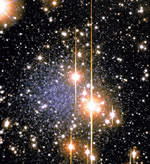
Image credit: UCSC
A team of astronomers from the University of Cambridge have been researching a rare group of galaxies, known as dwarf spheroidal galaxies, which seem to have few stars but massive amounts of “dark matter”. The team analyzed one such galaxy and found that the stars in the outer edges were moving so quickly that the galaxy could only stay together if it had 100 times more dark matter than the mass of the stars alone. This research will help astronomers understand how galaxies are formed and how dark matter plays into their composition.
New research on dwarf spheroidal galaxies by a team of astronomers at the University of Cambridge promises a real astronomical first: detection, for the first time, of the true outer limits of a galaxy.
The team is presenting today (23 July 2003) at the 25th General Assembly of the International Astronomical Union (IAUXXV) in Sydney, Australia. The research could provide the key to understanding how larger galaxies were formed, including our own Milky Way galaxy.
The rare dwarf spheroidal galaxies display few stars but contain massive amounts of ‘dark matter’ or matter that does not emit radiation that can be observed by astronomers. The team studied these galaxies in detail using some of the largest optical telescopes on earth in order to probe their dark secrets. Dwarf spheroidal galaxies are widely believed to be the building blocks from which galaxies were formed.
By studying the motion of many stars the scientists have created a picture of how the mass of the galaxy is arranged. Surprisingly, when the Cambridge team looked at the stars at the edge of one such galaxy, Draco, they found that the outer stars were moving so quickly that the galaxy could only stay together if it contained 100 times more dark matter than the mass of the stars alone. Using detailed models of the motions of stars in a galaxy containing large quantities of dark matter, the group was able to demonstrate their observations could only be understood if the galaxy was surrounded by a large halo of dark matter.
Observations of the Ursa Minor dwarf spheroidal galaxy presented a new complication in the study. The team found an unexpected clump of slow-moving stars interpreted as the dead remains of one of the pure star systems, a globular cluster. The cluster should have been scattered across the galaxy, but it was still held together. The team realised this was only possible if the dark matter were arranged in a manner very differently from standard galaxies.
In May 2003, further research into Ursa Minor showed the stars in the very outermost parts are not moving quickly like the stars at the edge of Draco. Several theories are being investigated including dark matter from edge of Ursa Minor has been snatched away from the galaxy by its massive parent, the Milky Way, allowing some stars to wander gently away from their parent. Or they could be stars which wandered too close to other stars in the centre of the galaxy and were slung out to the edge of the galaxy as a result.
Whatever the explanation, the findings promise a real astronomical first: detection, for the first time, of the true outer limits of a galaxy.
Gerry Gilmore, Professor of Experimental Philosophy at the Institute of Astronomy at the University of Cambridge, said:
“This research, utilising some of the largest optical telescopes on earth, has provided us with insight to the makeup of these rare dwarf galaxies. This research helps astronomers better understand how galaxies were formed, and help take into account dark matter in all galaxies.”
Original Source: Cambridge University News Release
